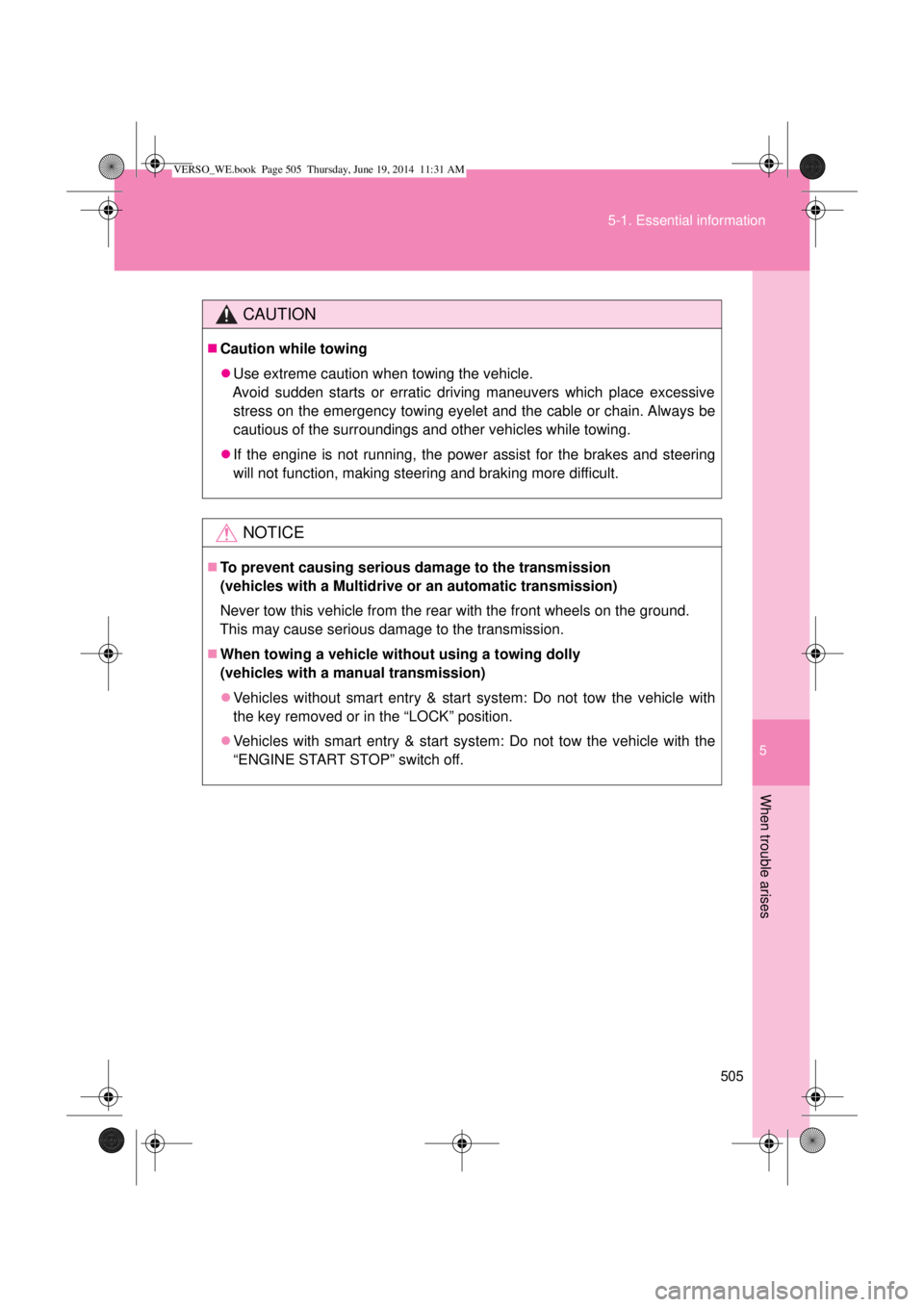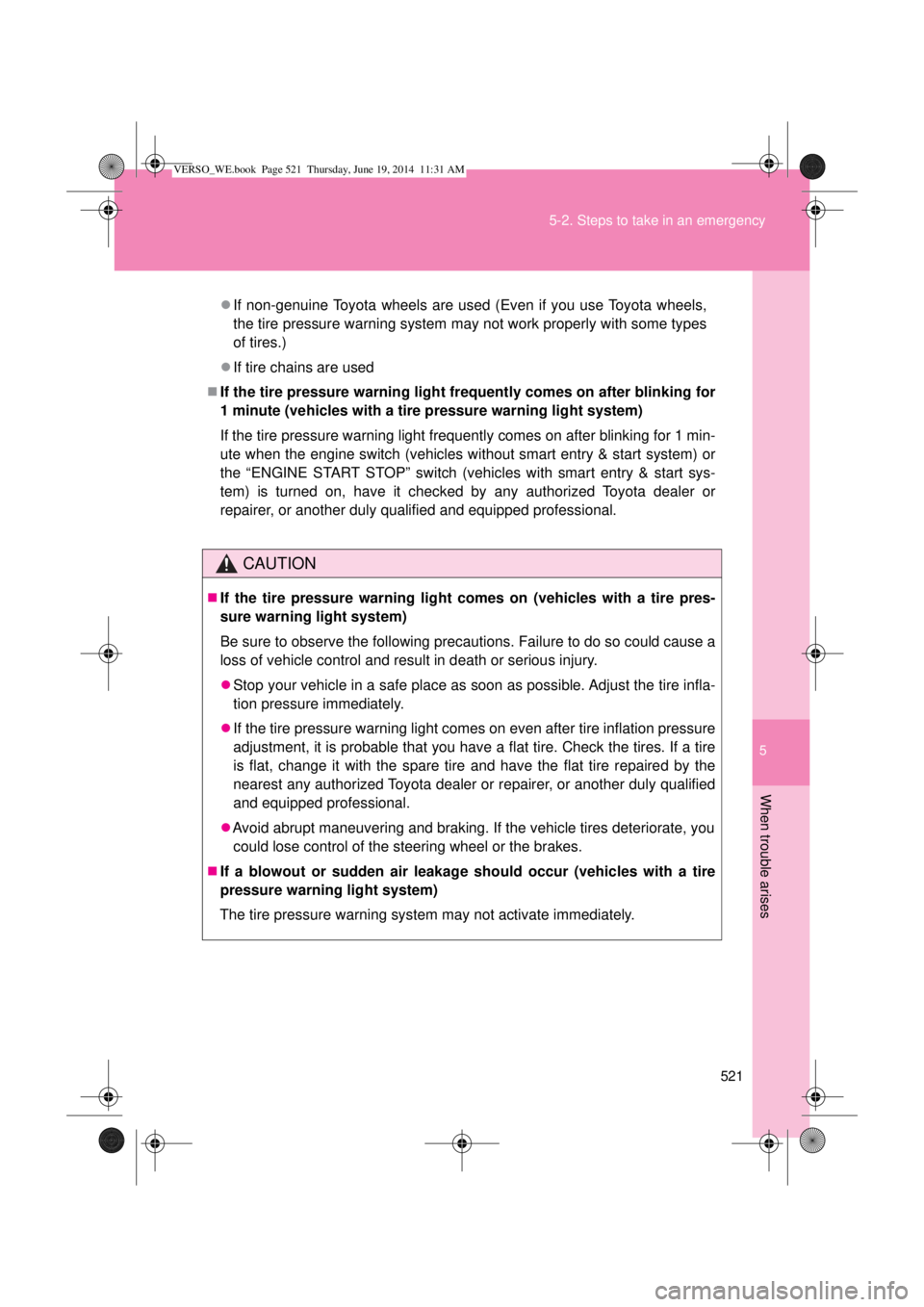Page 505 of 650

5
505 5-1. Essential information
When trouble arises
CAUTION
Caution while towing
Use extreme caution when towing the vehicle.
Avoid sudden starts or erratic driving maneuvers which place excessive
stress on the emergency towing eyelet and the cable or chain. Always be
cautious of the surroundings and other vehicles while towing.
If the engine is not running, the power assist for the brakes and steering
will not function, making steering and braking more difficult.
NOTICE
To prevent causing serious damage to the transmission
(vehicles with a Multidrive or an automatic transmission)
Never tow this vehicle from the rear with the front wheels on the ground.
This may cause serious damage to the transmission.
When towing a vehicle without using a towing dolly
(vehicles with a manual transmission)
Vehicles without smart entry & start system: Do not tow the vehicle with
the key removed or in the “LOCK” position.
Vehicles with smart entry & start system: Do not tow the vehicle with the
“ENGINE START STOP” switch off.
VERSO_WE.book Page 505 Thursday, June 19, 2014 11:31 AM
Page 510 of 650

510 5-1. Essential information
NOTICE
To prevent causing serious damage to the transmission
(vehicles with a Multidrive or an automatic transmission)
Never tow this vehicle from the rear with the front wheels on the ground.
When towing a vehicle without using a towing dolly (vehicles with a
manual transmission)
Vehicles without smart entry & start system: The engine switch must not
be in the “LOCK” position.
The steering lock mechanism is not strong enough to hold the front wheels
straight.
Vehicles with smart entry & start system: The “ENGINE START STOP”
switch must not be off.
The steering lock mechanism is not strong enough to hold the front wheels
straight.
To prevent damaging the vehicle (vehicles with a manual transmission)
Vehicles without smart entry & start system: Do not tow the vehicle from
the rear when the engine switch is in the “LOCK” position or the key is
removed. The steering lock mechanism is not strong enough to hold the
front wheels straight.
Vehicles with smart entry & start system: Do not tow the vehicle from the
rear with the “ENGINE START STOP” switch off. The steering lock mecha-
nism is not strong enough to hold the front wheels straight.
When raising the vehicle, ensure adequate ground clearance for towing at
the opposite end of the raised vehicle. Without adequate clearance, the
vehicle could be damaged while being towed.
VERSO_WE.book Page 510 Thursday, June 19, 2014 11:31 AM
Page 516 of 650

516 5-2. Steps to take in an emergency
*: Except South Africa and Morocco
(Comes on)Slip indicator light
Indicates a malfunction in:
• The VSC+ system; or
• The TRC system.
Automatic headlight leveling system warning light
(if equipped)
Indicates a malfunction in the automatic headlight leveling
system.
If the malfunction indicator lamp comes on while driving
For some models, the malfunction indicator lamp will come on if the fuel tank
becomes completely empty. If the fuel tank is empty, refuel the vehicle
immediately. The malfunction indicator lamp will go off after several trips.
If the malfunction indicator lamp does not go off, contact any authorized Toy-
ota dealer or repairer, or another duly qualified and equipped professional.
Electric power steering system warning light (warning buzzer)
When the battery charge becomes insufficient or the voltage temporarily
drops, the electric power steering system warning light may come on and the
warning buzzer may sound.
CAUTION
When the electric power steering system warning light comes on
The steering wheel may become extremely heavy.
If the steering wheel becomes heavier than usual when operating, hold
firmly and operate it using more force than usual.
Warning lightWarning light/Details
VERSO_WE.book Page 516 Thursday, June 19, 2014 11:31 AM
Page 521 of 650

5
521 5-2. Steps to take in an emergency
When trouble arises
If non-genuine Toyota wheels are used (Even if you use Toyota wheels,
the tire pressure warning system may not work properly with some types
of tires.)
If tire chains are used
If the tire pressure warning light frequently comes on after blinking for
1 minute (vehicles with a tire pressure warning light system)
If the tire pressure warning light frequently comes on after blinking for 1 min-
ute when the engine switch (vehicles without smart entry & start system) or
the “ENGINE START STOP” switch (vehicles with smart entry & start sys-
tem) is turned on, have it checked by any authorized Toyota dealer or
repairer, or another duly qualified and equipped professional.
CAUTION
If the tire pressure warning light comes on (vehicles with a tire pres-
sure warning light system)
Be sure to observe the following precautions. Failure to do so could cause a
loss of vehicle control and result in death or serious injury.
Stop your vehicle in a safe place as soon as possible. Adjust the tire infla-
tion pressure immediately.
If the tire pressure warning light comes on even after tire inflation pressure
adjustment, it is probable that you have a flat tire. Check the tires. If a tire
is flat, change it with the spare tire and have the flat tire repaired by the
nearest any authorized Toyota dealer or repairer, or another duly qualified
and equipped professional.
Avoid abrupt maneuvering and braking. If the vehicle tires deteriorate, you
could lose control of the steering wheel or the brakes.
If a blowout or sudden air leakage should occur (vehicles with a tire
pressure warning light system)
The tire pressure warning system may not activate immediately.
VERSO_WE.book Page 521 Thursday, June 19, 2014 11:31 AM
Page 535 of 650
5
535 5-2. Steps to take in an emergency
When trouble arises
*1: Vehicles with a Multidrive or an automatic transmission
*2: Vehicles with a manual transmission
Once
(Flashes)
(Green
indicator
flashes)Indicates that
the steering
lock has not
released within
3 seconds of
pressing the
“ENGINE
START STOP”
switch.Press the
“ENGINE
START STOP”
switch again
while turning
the steering
wheel with the
brake pedal
depressed.
Interior
buzzerExterior
buzzerWarning messageDetailsCorrection
procedure
VERSO_WE.book Page 535 Thursday, June 19, 2014 11:31 AM
Page 550 of 650

550 5-2. Steps to take in an emergency
CAUTION
Replacing a flat tire
Failure to follow these precautions could cause the wheel nuts to loosen
and the tire to fall off, resulting in death or serious injury.
• Have the wheel nuts tightened with a torque wrench to 103 N·m (10.5
kgf·m, 76 ft·lbf) as soon as possible after changing wheels.
• When installing a tire, only use wheel nuts that have been specifically
designed for that wheel.
• If there are any cracks or deformations in the bolt screws, nut threads
or bolt holes of the wheel, have the vehicle inspected by any autho-
rized Toyota dealer or repairer, or another duly qualified and equipped
professional.
• When installing the wheel nuts, be sure to install them with the tapered
ends facing inward. (P. 460)
• Do not attach a heavily damaged wheel ornament, as it may fly off the
wheel while the vehicle is moving.
When using the full-size spare tire (vehicles with the tire pressure
warning system or a spare tire of different wheel type from the installed
tires)
Replace the full-size spare tire with a standard tire as soon as possible.
Avoid sudden acceleration, deceleration and braking, as well as sharp cor-
nering.
When using the compact spare tire
Remember that your compact spare tire is specifically designed for use
with your vehicle. Do not use your compact spare tire on another vehicle.
Do not use more than one compact spare tire simultaneously.
Replace the compact spare tire with a standard tire as soon as possible.
Avoid sudden acceleration, abrupt steering, sudden braking and shifting
operations that cause sudden engine braking.
Speed limit when using the compact spare tire
Do not drive at speeds in excess of 80 km/h (50 mph) when a compact spare
tire is installed on the vehicle.
The compact spare tire is not designed for driving at high speeds. Failing to
observe this precaution may lead to an accident causing death or serious
injury.
VERSO_WE.book Page 550 Thursday, June 19, 2014 11:31 AM
Page 574 of 650

574 5-2. Steps to take in an emergency
CAUTION
Connect the valve and hose securely with the tire installed on the vehicle.
If the hose is not properly connected to the valve, air leakage may occur
as sealant may be sprayed out.
If the hose comes off the valve while inflating the tire, there is a risk that
the hose will move abruptly due to air pressure.
After inflation of the tire has completed, the sealant may splatter when the
hose is disconnected or some air is let out of the tire.
Follow the operation procedure to repair the tire. If the procedures not fol-
lowed, the sealant may spray out.
Keep back from the tire while it is being repaired, as there is a chance of it
bursting while the repair operation is being performed. If you notice any
cracks or deformation of the tire, turn off the compressor switch and stop
the repair operation immediately.
The repair kit may overheat if operated for a long period of time. Do not
operate the repair kit continuously for more than 40 minutes.
Parts of the repair kit become hot during operation. Be careful when han-
dling the repair kit during and after operation. Do not touch the metal part
around the connecting area between the bottle and compressor. It will be
extremely hot.
Do not attach the vehicle speed warning sticker to an area other than the
one indicated. If the sticker is attached to an area where an SRS airbag is
located, such as the pad of the steering wheel, it may prevent the SRS air-
bag from operating properly.
Driving to spread the liquid sealant evenly
Observe the following precautions to reduce the risk of accidents.
Failing to do so may result in a loss of vehicle control and cause death or
serious injury.
Drive the vehicle carefully at a low speed. Be especially careful when turn-
ing and cornering.
If the vehicle does not drive straight or you feel a pull through the steering
wheel, stop the vehicle and check the following.
• Tire condition. The tire may have separated from the wheel.
• Tire inflation pressure. If the tire inflation pressure is 130 kPa (1.3
kgf/cm
2 or bar, 19 psi) or less, the tire may be severely damaged.
VERSO_WE.book Page 574 Thursday, June 19, 2014 11:31 AM
Page 596 of 650
596 5-2. Steps to take in an emergency
CAUTION
If the engine has to be turned off while driving
Power assist for the brakes and steering wheel will be lost, making the
brake pedal harder to depress and the steering wheel heavier to turn.
Decelerate as much as possible before turning off the engine.
Vehicles without smart entry & start system: Never attempt to remove the
key, as doing so will lock the steering wheel.
Vehicles with smart entry &
start system: To stop the
engine, press and hold the
“ENGINE START STOP”
switch for 2 consecutive sec-
onds or more, or press it
briefly 3 times or more in suc-
cession.
Stop the vehicle in a safe place by the road.
Press and hold for 2 seconds or more,
or press briefly 3 times or more
VERSO_WE.book Page 596 Thursday, June 19, 2014 11:31 AM